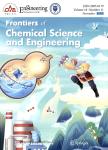Pd nano-catalyst supported on biowaste-derived porous nanofibrous carbon microspheres for efficient catalysis
作者机构:School of Materials and Architectural EngineeringGuizhou Normal UniversityGuiyang550025China College of Chemistry and Molecular SciencesWuhan UniversityWuhan430072China School of Textile Materials and EngineeringWuyi UniversityJiangmen529020China Guizhou Key Laboratory of Inorganic Nonmetallic Functional MaterialsGuizhou Normal UniversityGuiyang550025China
出 版 物:《Frontiers of Chemical Science and Engineering》 (化学科学与工程前沿(英文版))
年 卷 期:2023年第17卷第9期
页 面:1289-1300页
核心收录:
学科分类:081705[工学-工业催化] 08[工学] 0817[工学-化学工程与技术]
基 金:This work was supported by the Guizhou Provincial Science and Technology Foundation(Grant No.1Y212) the Science and Technology Top Talent Project of Guizhou Province(Grant No.029) the National Natural Science Foundation of China(Grant Nos.52063008 and 52103124) the Graduate Education Innovation Project of Guizhou Province(Grant No.099) the Guizhou Province Science and Technology Plan Project(Grant No.ZKKey 050) the Guizhou Key Laboratory of Inorganic Nonmetallic Functional Materials(Grant No.012) the Hundred Talents Project of Guizhou Province(Grant No.5673) the Lightweight Materials Engineering Research Center of the Education Department of Guizhou(Grant No.045) the Guizhou Province Science and Technology Support Plan(Grant Nos.4Y063 and04)
主 题:biowaste chitin nanofibrous palladium nano-catalyst catalysis
摘 要:Environmental pollution caused by the presence of aromatic aldehydes and dyes in wastewater is a serious global concern. An effective strategy for the removal of these pollutants is their catalytic conversion, possibly to valuable compounds. Therefore, the design of efficient, stable and long-lifetime catalysts is a worthwhile research goal. Herein, we used nanofibrous carbon microspheres (NCM) derived from the carbohydrate chitin present in seafood waste, and characterized by interconnected nanofibrous networks and N/O-containing groups, as carriers for the manufacture of a highly dispersed, efficient and stable Pd nano-catalyst (mean diameter ca. 2.52 nm). Importantly, the carbonised chitin’s graphitized structure, defect presence and large surface area could promote the transport of electrons between NCM and Pd, thereby endowing NCM supported Pd catalyst with high catalytic activity. The NCM supported Pd catalyst was employed in the degradation of some representative dyes and the chemoselective hydrogenation of aromatic aldehydes;this species exhibited excellent catalytic activity and stability, as well as applicability to a broad range of aromatic aldehydes, suggesting its potential use in green industrial catalysis.



